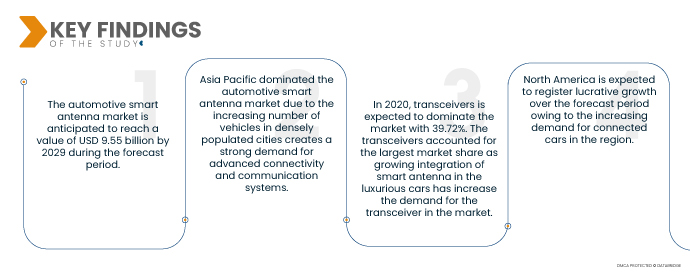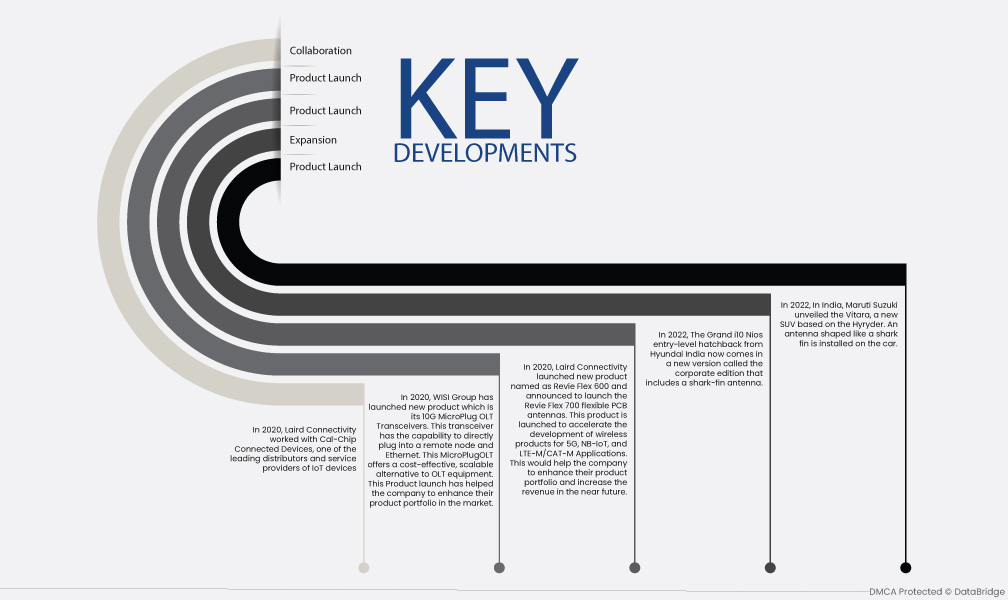The global automotive smart antenna market is experiencing significant growth due to various factors. Increasing consumer demand for advanced connectivity and communication features in vehicles, coupled with the rising adoption of electric vehicles, is driving the market. Smart antennas provide enhanced reception and transmission capabilities, enabling seamless integration of various vehicle technologies. Additionally, advancements in connected car technologies, such as 5G connectivity and V2X communication, are further propelling the market growth. The market is expected to expand during the forecast period, driven by these factors and the increasing focus on autonomous driving capabilities.
Access Full Report @ https://www.databridgemarketresearch.com/es/reports/global-automotive-smart-antenna-market
Data Bridge Market Research analyses that the Automotive Smart Antenna Market is valued at USD 3.06 billion in 2021 and is expected to reach USD 9.55 billion by 2029, registering a CAGR of 15.30% during the forecast period of 2022-2029. With the growing popularity of connected cars and the Internet of Things (IoT), there is a rising demand for advanced connectivity features in vehicles. Automotive smart antennas play a crucial role in enabling seamless connectivity by providing reliable and high-speed wireless communication for applications such as infotainment, telematics, navigation, and vehicle-to-vehicle communication.
Key Findings of the Study
Growing demand for improved reception and signal quality is expected to drive the market's growth rate
Traditional external antennas are often limited in their reception capabilities, especially in urban areas or locations with weak signals. Automotive smart antennas utilize advanced technologies like beamforming and signal processing algorithms to enhance signal reception, reduce interference, and improve overall signal quality. This improved reception is particularly valuable for better connectivity and enhanced user experiences, driving the adoption of smart antennas.
Report Scope and Market Segmentation
|
Report Metric
|
Details
|
|
Forecast Period
|
2022 to 2029
|
|
Base Year
|
2021
|
|
Historic Years
|
2020 (Customizable to 2014-2019)
|
|
Quantitative Units
|
Revenue in USD Million, Volumes in Units, Pricing in USD
|
|
Segments Covered
|
Frequency (High Frequency, Very High Frequency and Ultra High Frequency), Component (Transceivers, Electronic Control Unit, Wiring Harness and Others), Vehicle Type (ICE Vehicle and Electric Vehicle)
|
|
Countries Covered
|
U.S., Canada, Mexico, Brazil, Argentina, Rest of South America, Germany, Italy, U.K., France, Spain, Netherlands, Belgium, Switzerland, Turkey, Russia, Rest of Europe, Japan, China, India, South Korea, Australia, Singapore, Malaysia, Thailand, Indonesia, Philippines, Rest of Asia-Pacific, Saudi Arabia, U.A.E, South Africa, Egypt, Israel, Rest of Middle East and Africa
|
|
Market Players Covered
|
Laird Connectivity (U.S.), MD ELEKTRONIK (Germany), WISI group (Germany), Airgain, Inc. (U.S.), Continental AG (Germany), Ficosa Internacional SA (Spain), SCHAFFNER HOLDING AG (Switzerland), TE Connectivity (Switzerland), DENSO CORPORATION (Japan), HELLA GmbH & Co. KGaA (Germany), Calearo Antenne SPA (Italy), INPAQ Technology Co., Ltd. (Taiwan), Yokowo co., ltd (Japan), HARADA INDUSTRY CO., LTD (Japan), LOROM INDUSTRIAL CO. LTD. (China), Taoglas (Dublin), KDPOF (Spain) and STMicroelectronics (Switzerland) among others
|
|
Data Points Covered in the Report
|
In addition to the market insights such as market value, growth rate, market segments, geographical coverage, market players, and market scenario, the market report curated by the Data Bridge Market Research team includes in-depth expert analysis, import/export analysis, pricing analysis, production consumption analysis, and pestle analysis.
|
Segment Analysis:
The automotive smart antenna market is segmented on the basis of frequency, component and vehicle type.
- On the basis of frequency, the automotive smart antenna market is segmented into high frequency, very high frequency and ultra-high frequency. Very high frequency segment is expected to dominate the market with 38.8% market share due to the increasing safety of vehicles as well as driver.
In 2022, very high frequency segment is dominating in frequency segment in the automotive smart antenna market
Very high frequency segment is expected to dominate the market with 38.8% market share due to the increasing safety of vehicles as well as driver. Additionally, it offers a wide range of coverage that helps the driver to efficiently manage the route. This factor result in increased safety of the vehicle as well as the driver
- On the basis of component, the automotive smart antenna market is segmented into transceivers, electronic control unit, wiring harness and others. Transceivers is expected to dominate the market with 39.72% market share due to increase the demand for the transceiver in the market.
- On the basis of vehicle type, the automotive smart antenna market is segmented into ICE vehicle and electric vehicles. Internal Combustion Engine segment is expected to dominate the market with 81.33% market share due to increasing disposable income is boosting the demand for the vehicle in developed economies.
In 2022, the internal combustion engine segment is dominating in vehicle type segment in the automotive smart antenna market
In 2022, the internal combustion engine segment is expected to dominate the market with 81.33% market share due to increasing disposable income is boosting the demand for the vehicle in developed economies. Furthermore, the growing demand for passenger cars is boosting the demand for the vehicle in the developed economies.
Major Players
Data Bridge Market Research recognizes the following companies as the major automotive smart antenna market players in automotive smart antenna market are Laird Connectivity (U.S.), MD ELEKTRONIK (Germany), WISI group (Germany), Airgain, Inc. (U.S.), Continental AG (Germany), Ficosa Internacional SA (Spain), SCHAFFNER HOLDING AG (Switzerland), TE Connectivity (Switzerland), DENSO CORPORATION (Japan), HELLA GmbH & Co. KGaA (Germany).
Market Development
- In 2022, In India, Maruti Suzuki unveiled the Vitara, a new SUV based on the Hyryder. An antenna shaped like a shark fin is installed on the car.
- In 2022, The Grand i10 Nios entry-level hatchback from Hyundai India now comes in a new version called the corporate edition that includes a shark-fin antenna.
- In 2020, Laird Connectivity launched new product named as Revie Flex 600 and announced to launch the Revie Flex 700 flexible PCB antennas. This product is launched to accelerate the development of wireless products for 5G, NB-IoT, and LTE-M/CAT-M Applications. This would help the company to enhance their product portfolio and increase the revenue in the near future.
- In 2020, WISI Group has launched new product which is its 10G MicroPlug OLT Transceivers. This transceiver has the capability to directly plug into a remote node and Ethernet. This MicroPlugOLT offers a cost-effective, scalable alternative to OLT equipment. This Product launch has helped the company to enhance their product portfolio in the market.
- In 2020, Laird Connectivity worked with Cal-Chip Connected Devices, one of the leading distributors and service providers of IoT devices.
Regional Analysis
Geographically, the countries covered in the automotive smart antenna market report are U.S., Canada, Mexico, Brazil, Argentina, Rest of South America, Germany, Italy, U.K., France, Spain, Netherlands, Belgium, Switzerland, Turkey, Russia, Rest of Europe, Japan, China, India, South Korea, Australia, Singapore, Malaysia, Thailand, Indonesia, Philippines, Rest of Asia-Pacific, Saudi Arabia, U.A.E, South Africa, Egypt, Israel, Rest of Middle East and Africa
As per Data Bridge Market Research analysis:
Asia-Pacific is the dominant region in the automotive smart antenna market during the forecast period 2022-2029
Asia-Pacific (APAC) dominates the automotive smart antenna market due to the region's rising population and rapid urbanization. The increasing number of vehicles in densely populated cities creates a strong demand for advanced connectivity and communication systems. Additionally, the growing middle-class population in APAC countries fuels the adoption of smart vehicles with enhanced features, including smart antennas. These factors contribute to the dominance of APAC in the automotive smart antenna market.
North America is estimated to be the fastest-growing region in the automotive smart antenna market for the forecast period 2022-2029
North America is expected to experience significant growth in the automotive smart antenna market during the forecast period. This growth is attributed to the increasing demand for connected cars in the region. North American consumers have a strong affinity for advanced technology and connectivity features in their vehicles, driving the adoption of smart antennas. Additionally, the presence of major automotive manufacturers and technological advancements in the region further contribute to the growth of the market.
For more detailed information about the automotive smart antenna market report, click here – https://www.databridgemarketresearch.com/es/reports/global-automotive-smart-antenna-market














